Report on Business Communication, Negotiation, and Information Systems
VerifiedAdded on 2020/06/06
|9
|2696
|452
Report
AI Summary
This report delves into the core principles of business communication, examining the significance of negotiation within a business environment, exploring different negotiation approaches, and outlining key negotiation tactics. It further analyzes various presentation types, resource utilization for presentation development, presentation delivery methods, and best practices for collecting and using feedback. The report also investigates bespoke documents, their characteristics, creation factors, legal requirements for information gathering, and techniques for document creation and approval. Finally, it explores the stages of information systems development, the benefits and limitations of different systems, legal and security requirements, and methods for monitoring system effectiveness. The report uses M&S as a case study to understand these concepts in the fashion industry.
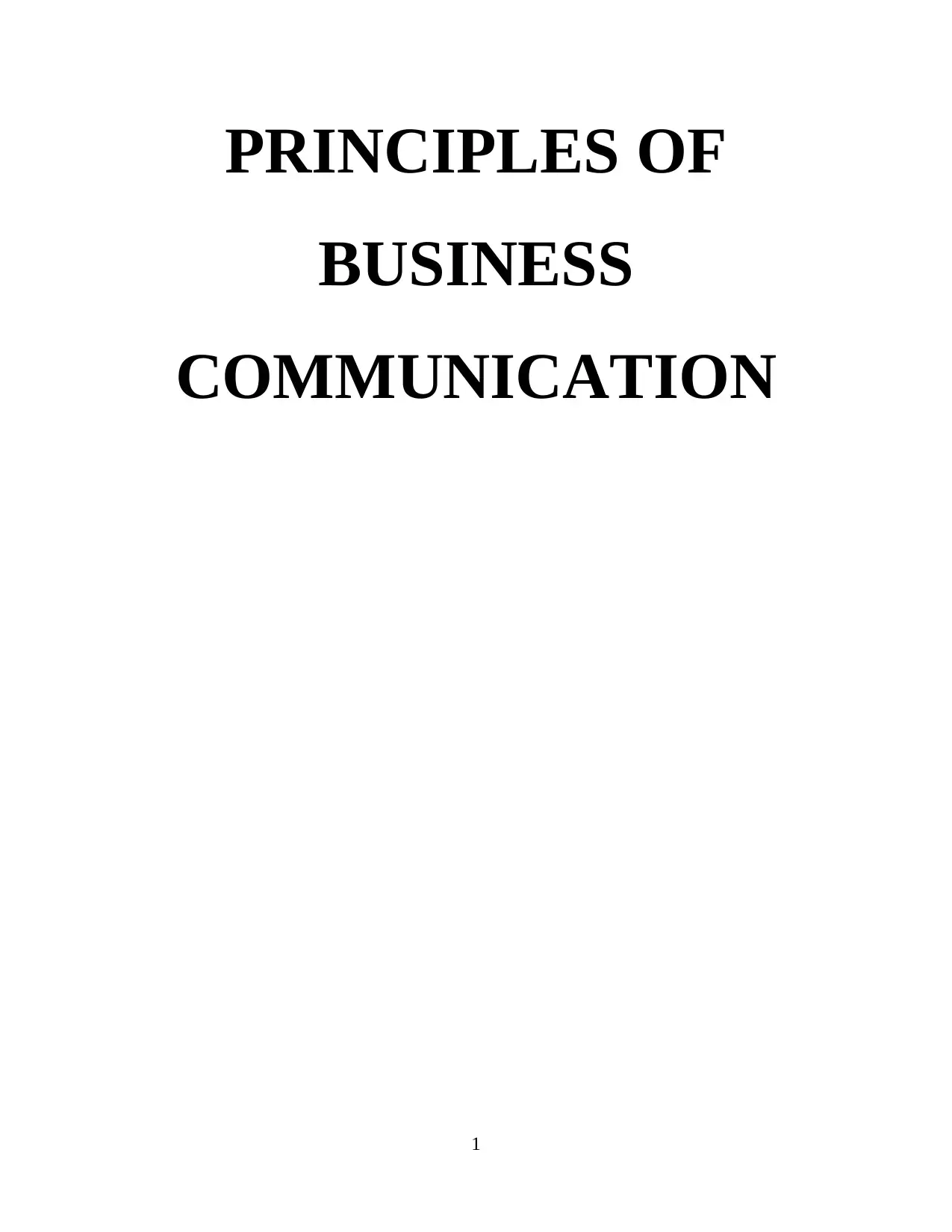
PRINCIPLES OF
BUSINESS
COMMUNICATION
1
BUSINESS
COMMUNICATION
1
Paraphrase This Document
Need a fresh take? Get an instant paraphrase of this document with our AI Paraphraser
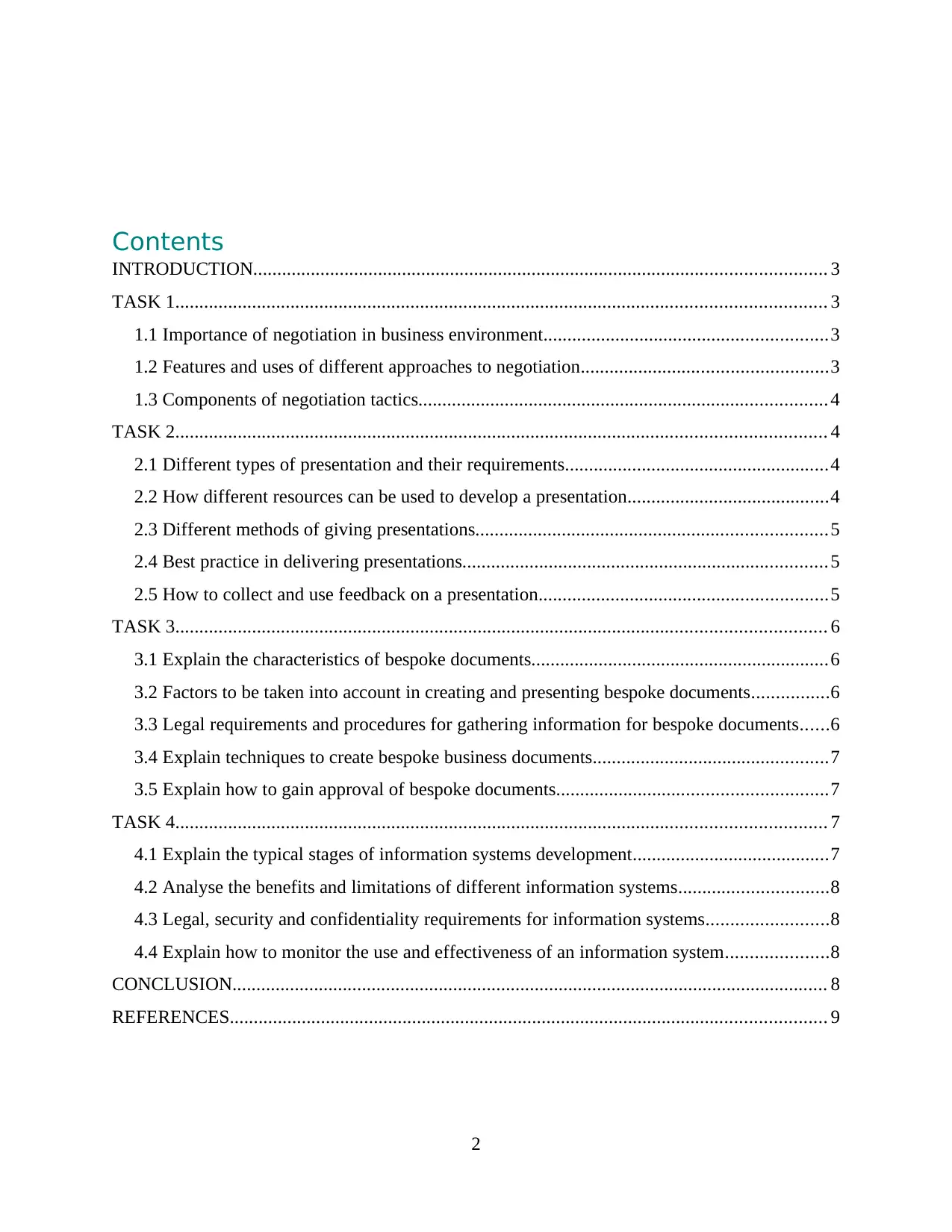
Contents
INTRODUCTION....................................................................................................................... 3
TASK 1....................................................................................................................................... 3
1.1 Importance of negotiation in business environment...........................................................3
1.2 Features and uses of different approaches to negotiation...................................................3
1.3 Components of negotiation tactics..................................................................................... 4
TASK 2....................................................................................................................................... 4
2.1 Different types of presentation and their requirements.......................................................4
2.2 How different resources can be used to develop a presentation..........................................4
2.3 Different methods of giving presentations.........................................................................5
2.4 Best practice in delivering presentations............................................................................5
2.5 How to collect and use feedback on a presentation............................................................5
TASK 3....................................................................................................................................... 6
3.1 Explain the characteristics of bespoke documents..............................................................6
3.2 Factors to be taken into account in creating and presenting bespoke documents................6
3.3 Legal requirements and procedures for gathering information for bespoke documents......6
3.4 Explain techniques to create bespoke business documents.................................................7
3.5 Explain how to gain approval of bespoke documents........................................................7
TASK 4....................................................................................................................................... 7
4.1 Explain the typical stages of information systems development.........................................7
4.2 Analyse the benefits and limitations of different information systems...............................8
4.3 Legal, security and confidentiality requirements for information systems.........................8
4.4 Explain how to monitor the use and effectiveness of an information system.....................8
CONCLUSION............................................................................................................................ 8
REFERENCES............................................................................................................................ 9
2
INTRODUCTION....................................................................................................................... 3
TASK 1....................................................................................................................................... 3
1.1 Importance of negotiation in business environment...........................................................3
1.2 Features and uses of different approaches to negotiation...................................................3
1.3 Components of negotiation tactics..................................................................................... 4
TASK 2....................................................................................................................................... 4
2.1 Different types of presentation and their requirements.......................................................4
2.2 How different resources can be used to develop a presentation..........................................4
2.3 Different methods of giving presentations.........................................................................5
2.4 Best practice in delivering presentations............................................................................5
2.5 How to collect and use feedback on a presentation............................................................5
TASK 3....................................................................................................................................... 6
3.1 Explain the characteristics of bespoke documents..............................................................6
3.2 Factors to be taken into account in creating and presenting bespoke documents................6
3.3 Legal requirements and procedures for gathering information for bespoke documents......6
3.4 Explain techniques to create bespoke business documents.................................................7
3.5 Explain how to gain approval of bespoke documents........................................................7
TASK 4....................................................................................................................................... 7
4.1 Explain the typical stages of information systems development.........................................7
4.2 Analyse the benefits and limitations of different information systems...............................8
4.3 Legal, security and confidentiality requirements for information systems.........................8
4.4 Explain how to monitor the use and effectiveness of an information system.....................8
CONCLUSION............................................................................................................................ 8
REFERENCES............................................................................................................................ 9
2
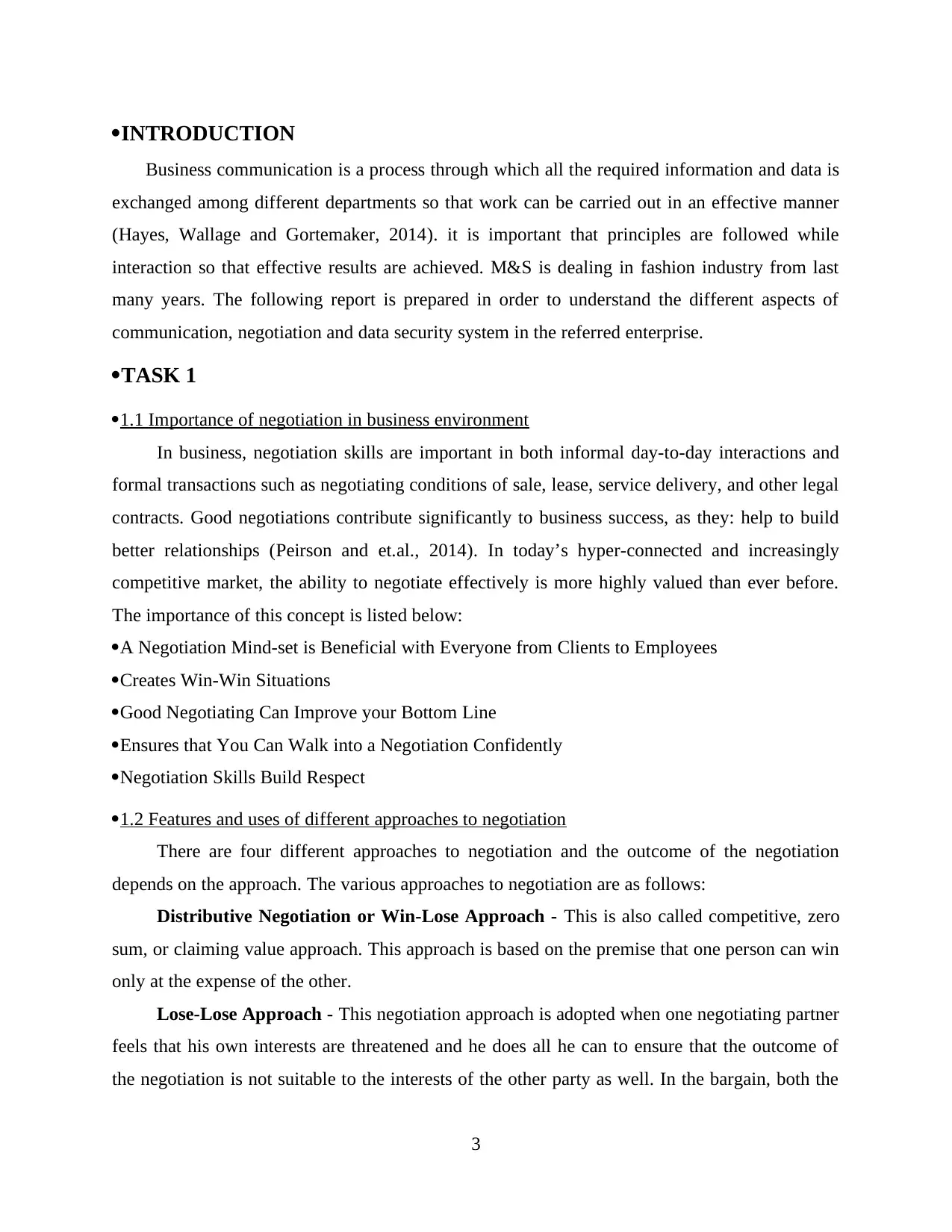
·INTRODUCTION
Business communication is a process through which all the required information and data is
exchanged among different departments so that work can be carried out in an effective manner
(Hayes, Wallage and Gortemaker, 2014). it is important that principles are followed while
interaction so that effective results are achieved. M&S is dealing in fashion industry from last
many years. The following report is prepared in order to understand the different aspects of
communication, negotiation and data security system in the referred enterprise.
·TASK 1
·1.1 Importance of negotiation in business environment
In business, negotiation skills are important in both informal day-to-day interactions and
formal transactions such as negotiating conditions of sale, lease, service delivery, and other legal
contracts. Good negotiations contribute significantly to business success, as they: help to build
better relationships (Peirson and et.al., 2014). In today’s hyper-connected and increasingly
competitive market, the ability to negotiate effectively is more highly valued than ever before.
The importance of this concept is listed below:
·A Negotiation Mind-set is Beneficial with Everyone from Clients to Employees
·Creates Win-Win Situations
·Good Negotiating Can Improve your Bottom Line
·Ensures that You Can Walk into a Negotiation Confidently
·Negotiation Skills Build Respect
·1.2 Features and uses of different approaches to negotiation
There are four different approaches to negotiation and the outcome of the negotiation
depends on the approach. The various approaches to negotiation are as follows:
Distributive Negotiation or Win-Lose Approach - This is also called competitive, zero
sum, or claiming value approach. This approach is based on the premise that one person can win
only at the expense of the other.
Lose-Lose Approach - This negotiation approach is adopted when one negotiating partner
feels that his own interests are threatened and he does all he can to ensure that the outcome of
the negotiation is not suitable to the interests of the other party as well. In the bargain, both the
3
Business communication is a process through which all the required information and data is
exchanged among different departments so that work can be carried out in an effective manner
(Hayes, Wallage and Gortemaker, 2014). it is important that principles are followed while
interaction so that effective results are achieved. M&S is dealing in fashion industry from last
many years. The following report is prepared in order to understand the different aspects of
communication, negotiation and data security system in the referred enterprise.
·TASK 1
·1.1 Importance of negotiation in business environment
In business, negotiation skills are important in both informal day-to-day interactions and
formal transactions such as negotiating conditions of sale, lease, service delivery, and other legal
contracts. Good negotiations contribute significantly to business success, as they: help to build
better relationships (Peirson and et.al., 2014). In today’s hyper-connected and increasingly
competitive market, the ability to negotiate effectively is more highly valued than ever before.
The importance of this concept is listed below:
·A Negotiation Mind-set is Beneficial with Everyone from Clients to Employees
·Creates Win-Win Situations
·Good Negotiating Can Improve your Bottom Line
·Ensures that You Can Walk into a Negotiation Confidently
·Negotiation Skills Build Respect
·1.2 Features and uses of different approaches to negotiation
There are four different approaches to negotiation and the outcome of the negotiation
depends on the approach. The various approaches to negotiation are as follows:
Distributive Negotiation or Win-Lose Approach - This is also called competitive, zero
sum, or claiming value approach. This approach is based on the premise that one person can win
only at the expense of the other.
Lose-Lose Approach - This negotiation approach is adopted when one negotiating partner
feels that his own interests are threatened and he does all he can to ensure that the outcome of
the negotiation is not suitable to the interests of the other party as well. In the bargain, both the
3
⊘ This is a preview!⊘
Do you want full access?
Subscribe today to unlock all pages.

Trusted by 1+ million students worldwide
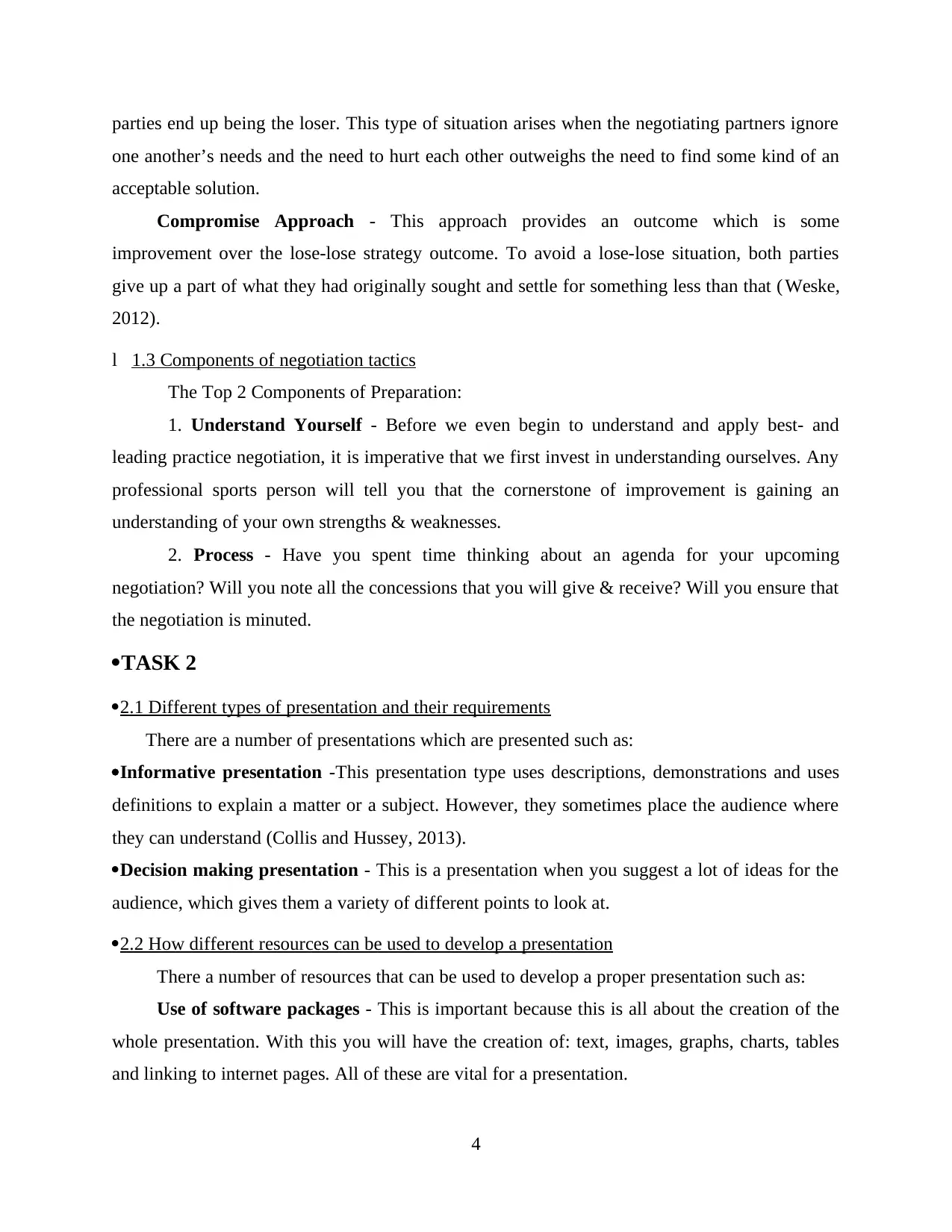
parties end up being the loser. This type of situation arises when the negotiating partners ignore
one another’s needs and the need to hurt each other outweighs the need to find some kind of an
acceptable solution.
Compromise Approach - This approach provides an outcome which is some
improvement over the lose-lose strategy outcome. To avoid a lose-lose situation, both parties
give up a part of what they had originally sought and settle for something less than that ( Weske,
2012).
l壱1.3 Components of negotiation tactics
The Top 2 Components of Preparation:
1. Understand Yourself - Before we even begin to understand and apply best- and
leading practice negotiation, it is imperative that we first invest in understanding ourselves. Any
professional sports person will tell you that the cornerstone of improvement is gaining an
understanding of your own strengths & weaknesses.
2. Process - Have you spent time thinking about an agenda for your upcoming
negotiation? Will you note all the concessions that you will give & receive? Will you ensure that
the negotiation is minuted.
·TASK 2
·2.1 Different types of presentation and their requirements
There are a number of presentations which are presented such as:
·Informative presentation -This presentation type uses descriptions, demonstrations and uses
definitions to explain a matter or a subject. However, they sometimes place the audience where
they can understand (Collis and Hussey, 2013).
·Decision making presentation - This is a presentation when you suggest a lot of ideas for the
audience, which gives them a variety of different points to look at.
·2.2 How different resources can be used to develop a presentation
There a number of resources that can be used to develop a proper presentation such as:
Use of software packages - This is important because this is all about the creation of the
whole presentation. With this you will have the creation of: text, images, graphs, charts, tables
and linking to internet pages. All of these are vital for a presentation.
4
one another’s needs and the need to hurt each other outweighs the need to find some kind of an
acceptable solution.
Compromise Approach - This approach provides an outcome which is some
improvement over the lose-lose strategy outcome. To avoid a lose-lose situation, both parties
give up a part of what they had originally sought and settle for something less than that ( Weske,
2012).
l壱1.3 Components of negotiation tactics
The Top 2 Components of Preparation:
1. Understand Yourself - Before we even begin to understand and apply best- and
leading practice negotiation, it is imperative that we first invest in understanding ourselves. Any
professional sports person will tell you that the cornerstone of improvement is gaining an
understanding of your own strengths & weaknesses.
2. Process - Have you spent time thinking about an agenda for your upcoming
negotiation? Will you note all the concessions that you will give & receive? Will you ensure that
the negotiation is minuted.
·TASK 2
·2.1 Different types of presentation and their requirements
There are a number of presentations which are presented such as:
·Informative presentation -This presentation type uses descriptions, demonstrations and uses
definitions to explain a matter or a subject. However, they sometimes place the audience where
they can understand (Collis and Hussey, 2013).
·Decision making presentation - This is a presentation when you suggest a lot of ideas for the
audience, which gives them a variety of different points to look at.
·2.2 How different resources can be used to develop a presentation
There a number of resources that can be used to develop a proper presentation such as:
Use of software packages - This is important because this is all about the creation of the
whole presentation. With this you will have the creation of: text, images, graphs, charts, tables
and linking to internet pages. All of these are vital for a presentation.
4
Paraphrase This Document
Need a fresh take? Get an instant paraphrase of this document with our AI Paraphraser
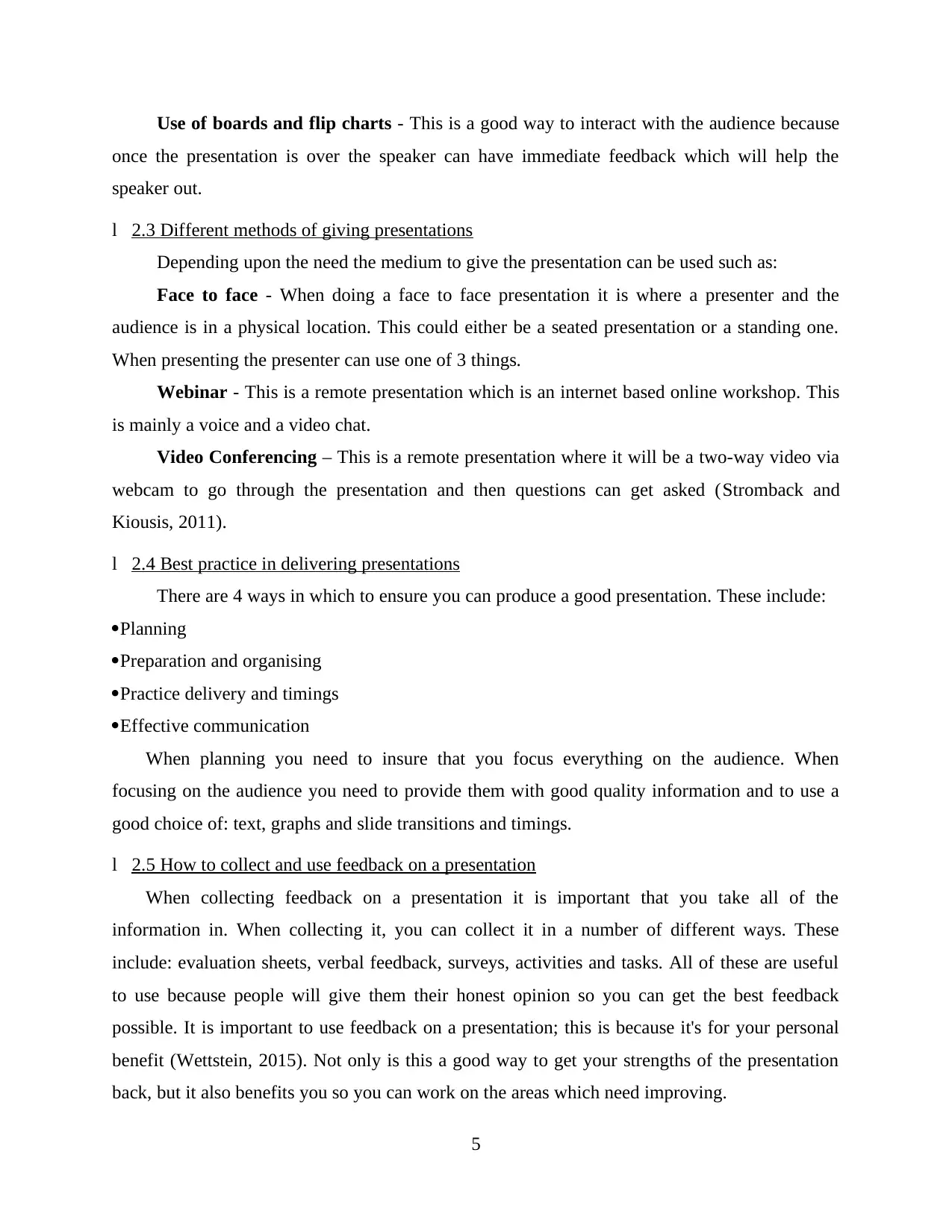
Use of boards and flip charts - This is a good way to interact with the audience because
once the presentation is over the speaker can have immediate feedback which will help the
speaker out.
l壱2.3 Different methods of giving presentations
Depending upon the need the medium to give the presentation can be used such as:
Face to face - When doing a face to face presentation it is where a presenter and the
audience is in a physical location. This could either be a seated presentation or a standing one.
When presenting the presenter can use one of 3 things.
Webinar - This is a remote presentation which is an internet based online workshop. This
is mainly a voice and a video chat.
Video Conferencing – This is a remote presentation where it will be a two-way video via
webcam to go through the presentation and then questions can get asked (Stromback and
Kiousis, 2011).
l壱2.4 Best practice in delivering presentations
There are 4 ways in which to ensure you can produce a good presentation. These include:
·Planning
·Preparation and organising
·Practice delivery and timings
·Effective communication
When planning you need to insure that you focus everything on the audience. When
focusing on the audience you need to provide them with good quality information and to use a
good choice of: text, graphs and slide transitions and timings.
l壱2.5 How to collect and use feedback on a presentation
When collecting feedback on a presentation it is important that you take all of the
information in. When collecting it, you can collect it in a number of different ways. These
include: evaluation sheets, verbal feedback, surveys, activities and tasks. All of these are useful
to use because people will give them their honest opinion so you can get the best feedback
possible. It is important to use feedback on a presentation; this is because it's for your personal
benefit (Wettstein, 2015). Not only is this a good way to get your strengths of the presentation
back, but it also benefits you so you can work on the areas which need improving.
5
once the presentation is over the speaker can have immediate feedback which will help the
speaker out.
l壱2.3 Different methods of giving presentations
Depending upon the need the medium to give the presentation can be used such as:
Face to face - When doing a face to face presentation it is where a presenter and the
audience is in a physical location. This could either be a seated presentation or a standing one.
When presenting the presenter can use one of 3 things.
Webinar - This is a remote presentation which is an internet based online workshop. This
is mainly a voice and a video chat.
Video Conferencing – This is a remote presentation where it will be a two-way video via
webcam to go through the presentation and then questions can get asked (Stromback and
Kiousis, 2011).
l壱2.4 Best practice in delivering presentations
There are 4 ways in which to ensure you can produce a good presentation. These include:
·Planning
·Preparation and organising
·Practice delivery and timings
·Effective communication
When planning you need to insure that you focus everything on the audience. When
focusing on the audience you need to provide them with good quality information and to use a
good choice of: text, graphs and slide transitions and timings.
l壱2.5 How to collect and use feedback on a presentation
When collecting feedback on a presentation it is important that you take all of the
information in. When collecting it, you can collect it in a number of different ways. These
include: evaluation sheets, verbal feedback, surveys, activities and tasks. All of these are useful
to use because people will give them their honest opinion so you can get the best feedback
possible. It is important to use feedback on a presentation; this is because it's for your personal
benefit (Wettstein, 2015). Not only is this a good way to get your strengths of the presentation
back, but it also benefits you so you can work on the areas which need improving.
5
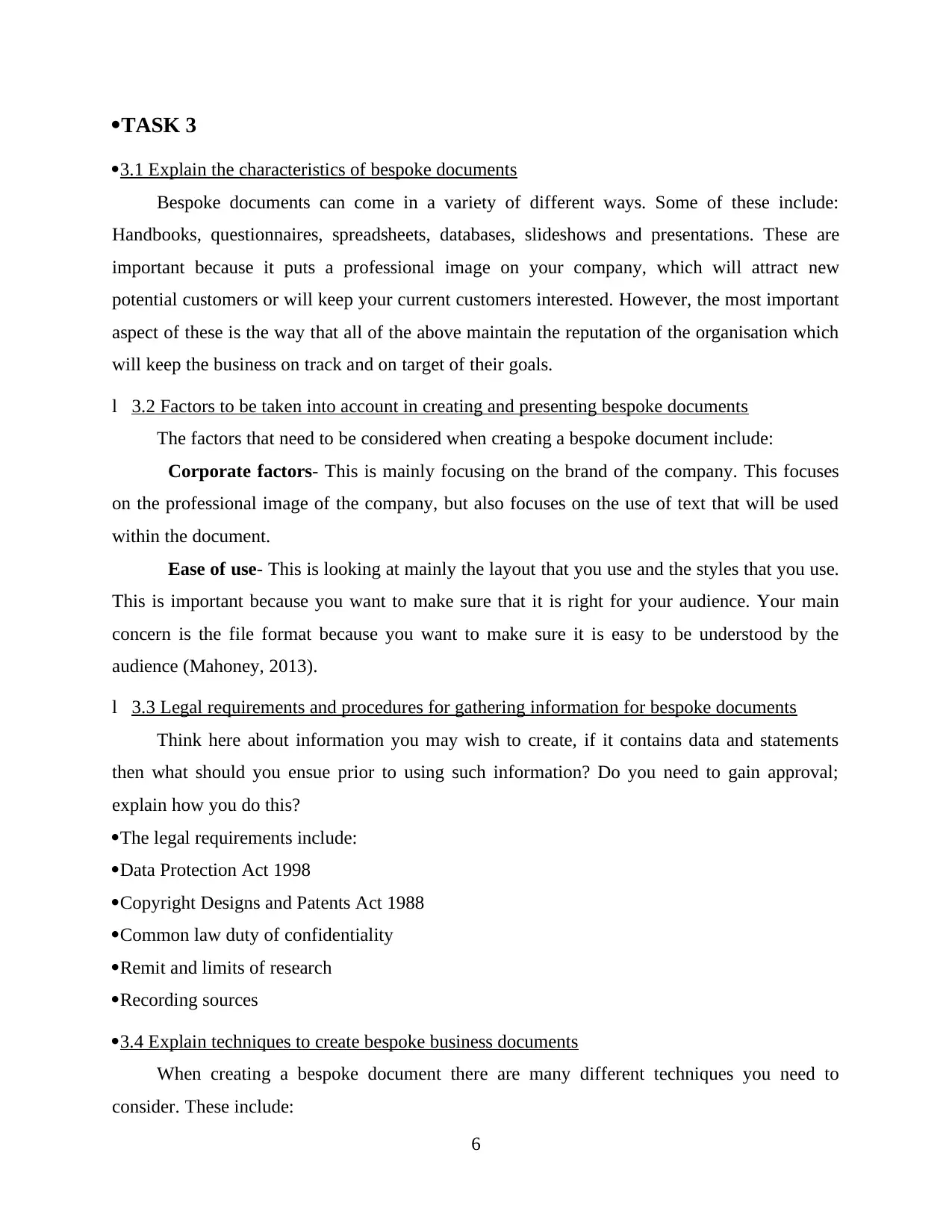
·TASK 3
·3.1 Explain the characteristics of bespoke documents
Bespoke documents can come in a variety of different ways. Some of these include:
Handbooks, questionnaires, spreadsheets, databases, slideshows and presentations. These are
important because it puts a professional image on your company, which will attract new
potential customers or will keep your current customers interested. However, the most important
aspect of these is the way that all of the above maintain the reputation of the organisation which
will keep the business on track and on target of their goals.
l壱3.2 Factors to be taken into account in creating and presenting bespoke documents
The factors that need to be considered when creating a bespoke document include:
Corporate factors- This is mainly focusing on the brand of the company. This focuses
on the professional image of the company, but also focuses on the use of text that will be used
within the document.
Ease of use- This is looking at mainly the layout that you use and the styles that you use.
This is important because you want to make sure that it is right for your audience. Your main
concern is the file format because you want to make sure it is easy to be understood by the
audience (Mahoney, 2013).
l壱3.3 Legal requirements and procedures for gathering information for bespoke documents
Think here about information you may wish to create, if it contains data and statements
then what should you ensue prior to using such information? Do you need to gain approval;
explain how you do this?
·The legal requirements include:
·Data Protection Act 1998
·Copyright Designs and Patents Act 1988
·Common law duty of confidentiality
·Remit and limits of research
·Recording sources
·3.4 Explain techniques to create bespoke business documents
When creating a bespoke document there are many different techniques you need to
consider. These include:
6
·3.1 Explain the characteristics of bespoke documents
Bespoke documents can come in a variety of different ways. Some of these include:
Handbooks, questionnaires, spreadsheets, databases, slideshows and presentations. These are
important because it puts a professional image on your company, which will attract new
potential customers or will keep your current customers interested. However, the most important
aspect of these is the way that all of the above maintain the reputation of the organisation which
will keep the business on track and on target of their goals.
l壱3.2 Factors to be taken into account in creating and presenting bespoke documents
The factors that need to be considered when creating a bespoke document include:
Corporate factors- This is mainly focusing on the brand of the company. This focuses
on the professional image of the company, but also focuses on the use of text that will be used
within the document.
Ease of use- This is looking at mainly the layout that you use and the styles that you use.
This is important because you want to make sure that it is right for your audience. Your main
concern is the file format because you want to make sure it is easy to be understood by the
audience (Mahoney, 2013).
l壱3.3 Legal requirements and procedures for gathering information for bespoke documents
Think here about information you may wish to create, if it contains data and statements
then what should you ensue prior to using such information? Do you need to gain approval;
explain how you do this?
·The legal requirements include:
·Data Protection Act 1998
·Copyright Designs and Patents Act 1988
·Common law duty of confidentiality
·Remit and limits of research
·Recording sources
·3.4 Explain techniques to create bespoke business documents
When creating a bespoke document there are many different techniques you need to
consider. These include:
6
⊘ This is a preview!⊘
Do you want full access?
Subscribe today to unlock all pages.

Trusted by 1+ million students worldwide
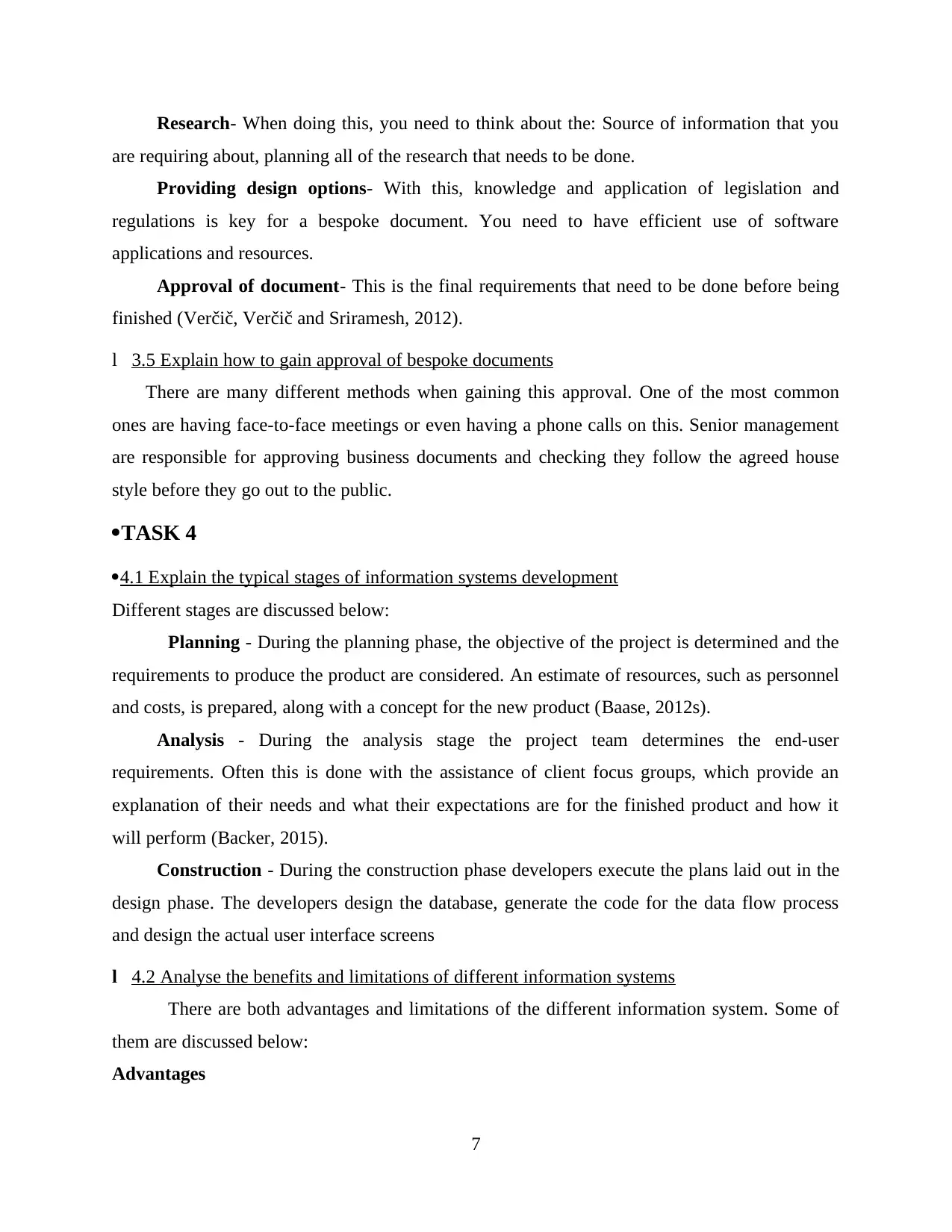
Research- When doing this, you need to think about the: Source of information that you
are requiring about, planning all of the research that needs to be done.
Providing design options- With this, knowledge and application of legislation and
regulations is key for a bespoke document. You need to have efficient use of software
applications and resources.
Approval of document- This is the final requirements that need to be done before being
finished (Verčič, Verčič and Sriramesh, 2012).
l壱3.5 Explain how to gain approval of bespoke documents
There are many different methods when gaining this approval. One of the most common
ones are having face-to-face meetings or even having a phone calls on this. Senior management
are responsible for approving business documents and checking they follow the agreed house
style before they go out to the public.
·TASK 4
·4.1 Explain the typical stages of information systems development
Different stages are discussed below:
Planning - During the planning phase, the objective of the project is determined and the
requirements to produce the product are considered. An estimate of resources, such as personnel
and costs, is prepared, along with a concept for the new product (Baase, 2012s).
Analysis - During the analysis stage the project team determines the end-user
requirements. Often this is done with the assistance of client focus groups, which provide an
explanation of their needs and what their expectations are for the finished product and how it
will perform (Backer, 2015).
Construction - During the construction phase developers execute the plans laid out in the
design phase. The developers design the database, generate the code for the data flow process
and design the actual user interface screens
l壱4.2 Analyse the benefits and limitations of different information systems
There are both advantages and limitations of the different information system. Some of
them are discussed below:
Advantages
7
are requiring about, planning all of the research that needs to be done.
Providing design options- With this, knowledge and application of legislation and
regulations is key for a bespoke document. You need to have efficient use of software
applications and resources.
Approval of document- This is the final requirements that need to be done before being
finished (Verčič, Verčič and Sriramesh, 2012).
l壱3.5 Explain how to gain approval of bespoke documents
There are many different methods when gaining this approval. One of the most common
ones are having face-to-face meetings or even having a phone calls on this. Senior management
are responsible for approving business documents and checking they follow the agreed house
style before they go out to the public.
·TASK 4
·4.1 Explain the typical stages of information systems development
Different stages are discussed below:
Planning - During the planning phase, the objective of the project is determined and the
requirements to produce the product are considered. An estimate of resources, such as personnel
and costs, is prepared, along with a concept for the new product (Baase, 2012s).
Analysis - During the analysis stage the project team determines the end-user
requirements. Often this is done with the assistance of client focus groups, which provide an
explanation of their needs and what their expectations are for the finished product and how it
will perform (Backer, 2015).
Construction - During the construction phase developers execute the plans laid out in the
design phase. The developers design the database, generate the code for the data flow process
and design the actual user interface screens
l壱4.2 Analyse the benefits and limitations of different information systems
There are both advantages and limitations of the different information system. Some of
them are discussed below:
Advantages
7
Paraphrase This Document
Need a fresh take? Get an instant paraphrase of this document with our AI Paraphraser
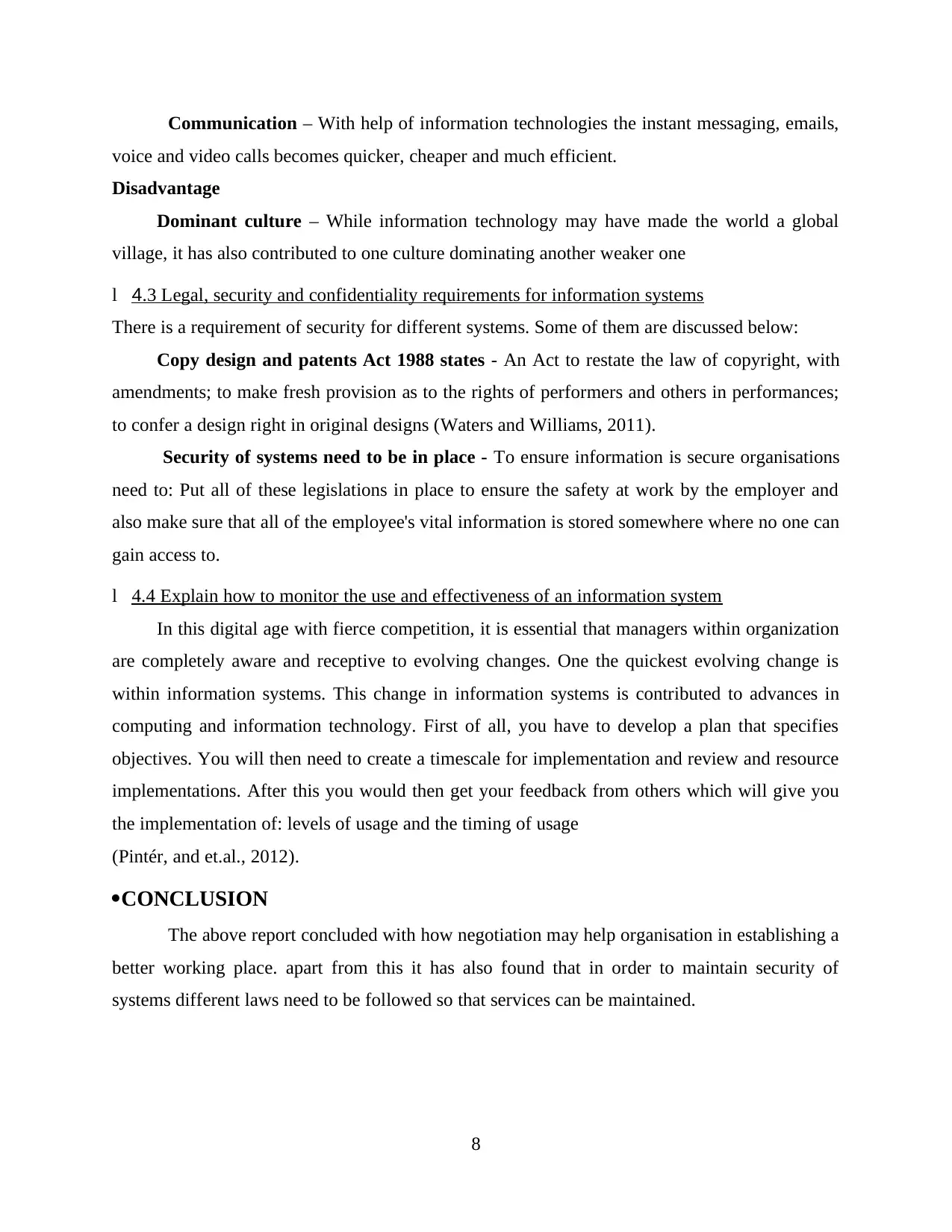
Communication – With help of information technologies the instant messaging, emails,
voice and video calls becomes quicker, cheaper and much efficient.
Disadvantage
Dominant culture – While information technology may have made the world a global
village, it has also contributed to one culture dominating another weaker one
l壱4.3 Legal, security and confidentiality requirements for information systems
There is a requirement of security for different systems. Some of them are discussed below:
Copy design and patents Act 1988 states - An Act to restate the law of copyright, with
amendments; to make fresh provision as to the rights of performers and others in performances;
to confer a design right in original designs (Waters and Williams, 2011).
Security of systems need to be in place - To ensure information is secure organisations
need to: Put all of these legislations in place to ensure the safety at work by the employer and
also make sure that all of the employee's vital information is stored somewhere where no one can
gain access to.
l壱4.4 Explain how to monitor the use and effectiveness of an information system
In this digital age with fierce competition, it is essential that managers within organization
are completely aware and receptive to evolving changes. One the quickest evolving change is
within information systems. This change in information systems is contributed to advances in
computing and information technology. First of all, you have to develop a plan that specifies
objectives. You will then need to create a timescale for implementation and review and resource
implementations. After this you would then get your feedback from others which will give you
the implementation of: levels of usage and the timing of usage
(Pintér, and et.al., 2012).
·CONCLUSION
The above report concluded with how negotiation may help organisation in establishing a
better working place. apart from this it has also found that in order to maintain security of
systems different laws need to be followed so that services can be maintained.
8
voice and video calls becomes quicker, cheaper and much efficient.
Disadvantage
Dominant culture – While information technology may have made the world a global
village, it has also contributed to one culture dominating another weaker one
l壱4.3 Legal, security and confidentiality requirements for information systems
There is a requirement of security for different systems. Some of them are discussed below:
Copy design and patents Act 1988 states - An Act to restate the law of copyright, with
amendments; to make fresh provision as to the rights of performers and others in performances;
to confer a design right in original designs (Waters and Williams, 2011).
Security of systems need to be in place - To ensure information is secure organisations
need to: Put all of these legislations in place to ensure the safety at work by the employer and
also make sure that all of the employee's vital information is stored somewhere where no one can
gain access to.
l壱4.4 Explain how to monitor the use and effectiveness of an information system
In this digital age with fierce competition, it is essential that managers within organization
are completely aware and receptive to evolving changes. One the quickest evolving change is
within information systems. This change in information systems is contributed to advances in
computing and information technology. First of all, you have to develop a plan that specifies
objectives. You will then need to create a timescale for implementation and review and resource
implementations. After this you would then get your feedback from others which will give you
the implementation of: levels of usage and the timing of usage
(Pintér, and et.al., 2012).
·CONCLUSION
The above report concluded with how negotiation may help organisation in establishing a
better working place. apart from this it has also found that in order to maintain security of
systems different laws need to be followed so that services can be maintained.
8
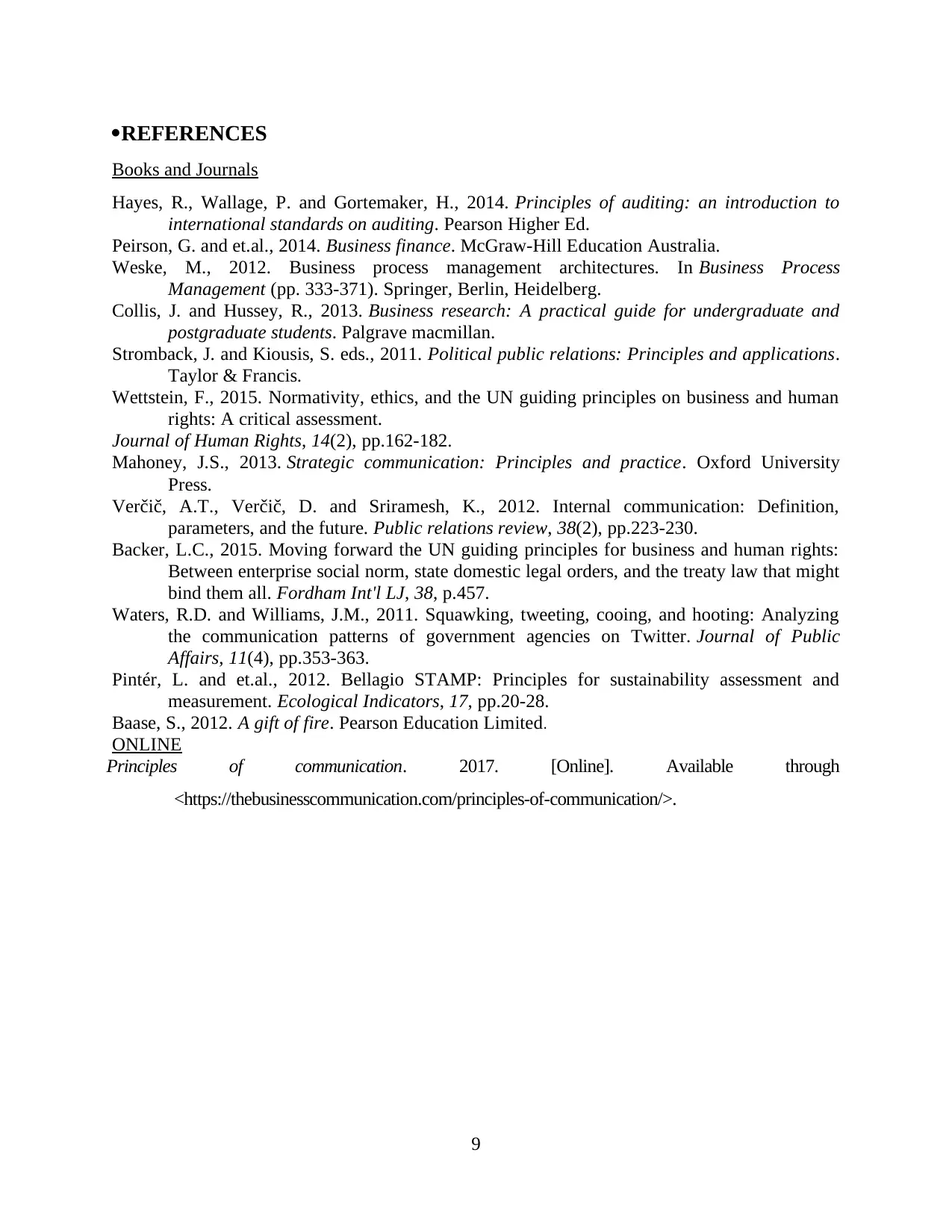
·REFERENCES
Books and Journals
Hayes, R., Wallage, P. and Gortemaker, H., 2014. Principles of auditing: an introduction to
international standards on auditing. Pearson Higher Ed.
Peirson, G. and et.al., 2014. Business finance. McGraw-Hill Education Australia.
Weske, M., 2012. Business process management architectures. In Business Process
Management (pp. 333-371). Springer, Berlin, Heidelberg.
Collis, J. and Hussey, R., 2013. Business research: A practical guide for undergraduate and
postgraduate students. Palgrave macmillan.
Stromback, J. and Kiousis, S. eds., 2011. Political public relations: Principles and applications.
Taylor & Francis.
Wettstein, F., 2015. Normativity, ethics, and the UN guiding principles on business and human
rights: A critical assessment.
Journal of Human Rights, 14(2), pp.162-182.
Mahoney, J.S., 2013. Strategic communication: Principles and practice. Oxford University
Press.
Verčič, A.T., Verčič, D. and Sriramesh, K., 2012. Internal communication: Definition,
parameters, and the future. Public relations review, 38(2), pp.223-230.
Backer, L.C., 2015. Moving forward the UN guiding principles for business and human rights:
Between enterprise social norm, state domestic legal orders, and the treaty law that might
bind them all. Fordham Int'l LJ, 38, p.457.
Waters, R.D. and Williams, J.M., 2011. Squawking, tweeting, cooing, and hooting: Analyzing
the communication patterns of government agencies on Twitter. Journal of Public
Affairs, 11(4), pp.353-363.
Pintér, L. and et.al., 2012. Bellagio STAMP: Principles for sustainability assessment and
measurement. Ecological Indicators, 17, pp.20-28.
Baase, S., 2012. A gift of fire. Pearson Education Limited.
ONLINE
Principles of communication. 2017. [Online]. Available through
<https://thebusinesscommunication.com/principles-of-communication/>.
9
Books and Journals
Hayes, R., Wallage, P. and Gortemaker, H., 2014. Principles of auditing: an introduction to
international standards on auditing. Pearson Higher Ed.
Peirson, G. and et.al., 2014. Business finance. McGraw-Hill Education Australia.
Weske, M., 2012. Business process management architectures. In Business Process
Management (pp. 333-371). Springer, Berlin, Heidelberg.
Collis, J. and Hussey, R., 2013. Business research: A practical guide for undergraduate and
postgraduate students. Palgrave macmillan.
Stromback, J. and Kiousis, S. eds., 2011. Political public relations: Principles and applications.
Taylor & Francis.
Wettstein, F., 2015. Normativity, ethics, and the UN guiding principles on business and human
rights: A critical assessment.
Journal of Human Rights, 14(2), pp.162-182.
Mahoney, J.S., 2013. Strategic communication: Principles and practice. Oxford University
Press.
Verčič, A.T., Verčič, D. and Sriramesh, K., 2012. Internal communication: Definition,
parameters, and the future. Public relations review, 38(2), pp.223-230.
Backer, L.C., 2015. Moving forward the UN guiding principles for business and human rights:
Between enterprise social norm, state domestic legal orders, and the treaty law that might
bind them all. Fordham Int'l LJ, 38, p.457.
Waters, R.D. and Williams, J.M., 2011. Squawking, tweeting, cooing, and hooting: Analyzing
the communication patterns of government agencies on Twitter. Journal of Public
Affairs, 11(4), pp.353-363.
Pintér, L. and et.al., 2012. Bellagio STAMP: Principles for sustainability assessment and
measurement. Ecological Indicators, 17, pp.20-28.
Baase, S., 2012. A gift of fire. Pearson Education Limited.
ONLINE
Principles of communication. 2017. [Online]. Available through
<https://thebusinesscommunication.com/principles-of-communication/>.
9
⊘ This is a preview!⊘
Do you want full access?
Subscribe today to unlock all pages.

Trusted by 1+ million students worldwide
1 out of 9
Related Documents
Your All-in-One AI-Powered Toolkit for Academic Success.
+13062052269
info@desklib.com
Available 24*7 on WhatsApp / Email
![[object Object]](/_next/static/media/star-bottom.7253800d.svg)
Unlock your academic potential
Copyright © 2020–2025 A2Z Services. All Rights Reserved. Developed and managed by ZUCOL.





